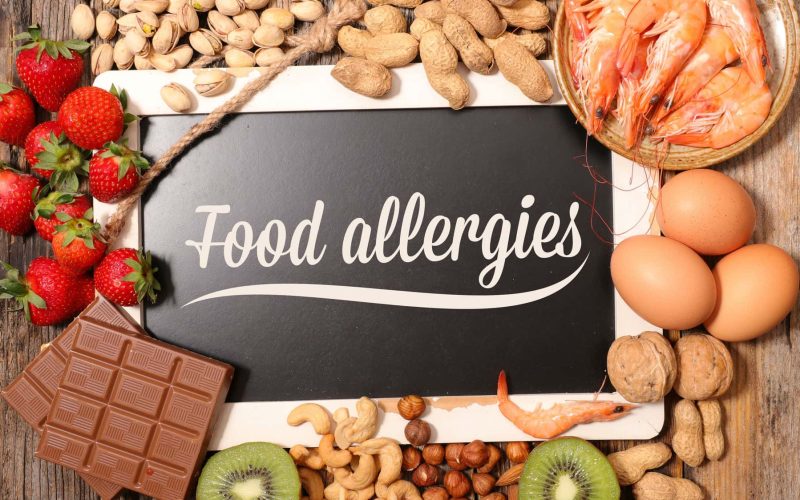Food allergy is a widespread problem that between 6 to 8% of children lower than three years of age, and about 3% of adults around the world have to deal with.
While it is known that no cure for food allergy exists, it is also true that so many children outgrow their food allergies.
There is a big difference between food allergies and food intolerance, but it is prevalent for people to mistake both. While food tolerance can be very discomforting, it lasts only very temporarily and has nothing to do with the immune system.
As we proceed with this article, we will be discussing the symptoms, causes, and risk factors associated with food allergy.
What are the symptoms of a food allergy?
For some people who deal with allergies, their allergic reactions to specific foods may not be severe. For some others, an allergic food reaction may be frightening and sometimes life-threatening.
The symptoms of food allergy usually show up within an hour or two after the consumption of offending foods. There are several signs and symptoms of allergy, but the most common ones include:
- Hives, itching or eczema
- Itching or tingling in the mouth
- Wheezing, trouble breathing and nasal congestion
- Swelling of the lips, tongue, face, throat and other body parts
- Fainting, dizziness, and lightheadedness
- Nausea or vomiting, diarrhea, and abdominal pains
Anaphylaxis
In specific individuals, a food allergy can lead to a severe allergic reaction known as anaphylaxis. This reaction can cause some life-threatening signs and symptoms such as:
- Shock with a sharp drop in blood pressure
- Constriction and tightening of the airways
- Rapid pulse
- A swollen throat or the feeling or a lump in your throat that makes it hard to breathe
- Lightheadedness, dizziness, and even loss of consciousness
There is a need for emergency treatment in cases of anaphylaxis. If left untreated immediately, it can lead to coma, or death in worse situations.
When should you see a doctor?
If you or anyone around you notice food allergy symptoms shortly after eating anything, you should see a doctor or an allergist. If it is possible to see a doctor immediately, the food allergy is occurring; it will be best.
This will also help your doctor or allergist make a diagnosis. Opt for emergency treatment if you get any signs and symptoms of anaphylaxis such as:
- Rapid pulse
- Constriction of airways that may lead to breathing difficulties
- Dizziness or lightheadedness
- Shock with a severe drop in blood pressure
Causes of food allergy
When you have a food allergy, specific foods are identified as harmful by your immune system (These foods are not usually bad foods or even harmful to other people).
In response to the intake of these offending foods, your immune system causes cells to release an antibody called immunoglobulin E (IgE) which has the duty of neutralizing the food or food substances that cause allergic reactions.
The next time you consume such foods, your immune system is signaled to release a chemical known as histamine, as well as some other chemicals into your bloodstream. The chemicals that are released into the bloodstream are what causes the allergic reaction.
In grownups, the majority of food allergies show as when triggered by specific proteins. Some of the allergy-causing proteins include:
- Fish
- Peanuts
- Shellfish like lobsters, crabs, and shrimps
- Tree nuts, such as pecans and walnuts
In children, food allergies can be triggered by proteins in the following foods:
- Eggs
- Peanuts
- Tree nuts
- Soy
- Cow’s milk
- Wheat
Pollen-food allergy syndrome
Pollen-food allergy syndrome is also known as oral allergy syndrome, and it is known to affect people who have hay fever mostly.
In the case of pollen-food allergy syndrome, some specific fruits, and vegetables, or spices and nuts can trigger an allergic reaction that makes the mouth itch or tingle.
In severe cases, the allergic reaction to these foods causes there may be swelling of the anaphylaxis or throat.
Proteins in some fruits and vegetables cause the reaction because they are similar to an allergy, causing proteins in specific pollens. We can call this an example of cross-reactivity.
If you decide to cook foods that trigger pollen-food allergy syndrome, you have experienced less severe symptoms.
The table that follows displays the specific nuts and spices, fruits, and vegetables that can lead to pollen-food allergy syndrome in individuals who are allergic to various kinds of pollen.
| If you are allergic to | Birch pollen | Ragweed pollen | Grasses | Mugwort pollen |
| You may also react to | Almond
Apple Apricot Carrot Celery Cherry Hazelnut Peach Peanut Pear Plum Raw potatoes Soybean Some herbs and spices (anise, caraway, coriander, fennel, parsley) | Banana
Cucumber Melons ( cantaloupe, honeydew, and watermelon) Zucchini | Cucumber
Melons (cantaloupe, honeydew, and watermelon) Peanut Tomato Orange White potatoes Zucchini | Apples
Bell pepper Broccoli Cabbage Carrots Celery Garlic Cauliflower Onion Peach Some herbs and spices (anise, coriander, black pepper, caraway seed, mustard, fennel, parsley) |
Exercised caused food allergy
Feeding on some particular foods may make some people feel lightheaded and itchy soon after working out.
Severe cases may even lead to anaphylaxis or hives. Not eating for some hours before working out and avoiding certain foods may help to prevent the discomfort of food allergy.
Food intolerance and other reactions
A case of food intolerance or an allergic reaction to something else that you ate may bring forth the same signs as symptoms that food allergy causes. Symptoms like nausea, vomiting, diarrhea, and cramping as what you may expect to experience.
Depending on what time of food intolerance you are dealing with, you may be able to eat tiny amounts of the foods you react to without dealing with any reactions. If you have a food allergy, on the other hand, even a minimal amount of food may cause an allergic reaction.
The strangest and trickiest part of diagnosing food intolerance is that a person may not be sensitive to the food itself but the ingredients with which the food was prepared.
There are common conditions that may lead to symptoms similar to food allergy, and they include:
Food poisoning
Sometimes, the signs of food poisoning can mock an allergic reaction. The bacteria in spoilt fish like tuna, and many others can create a toxin that causes a harmful reaction.
Absence of an enzyme that is needed for the full digestion of food
You may be lacking an adequate amount of specific enzymes required for the digestion of some foods.
Insufficient amount of the proteins such as lactase, for instance, will lessen your ability to digest milk or lactose. Lactose intolerance may lead to cramping, bloating, excess gas, and diarrhea.
Histamine toxicity
Some fishes like tuna or mackerel that are not properly refrigerated, and also contain high amounts of bacteria may have high histamine levels that will trigger allergic reactions.
Instead of an allergic reaction, this reaction is called scombroid poisoning or histamine toxicity.
Celiac disease
While celiac disease is also known as a gluten allergy, it is not known to cause anaphylaxis. Its reactions may even be worse than that of a mild food allergy.
Sensitivity to food additives
Some people have sensitive reactions to certain food additives. When such people eat foods with offending additives, such as sulfites that are used for the preservation of dried fruits, wine, and canned foods, it may trigger an asthma attack.
Risk factors
The risk factors for a food allergy include:
- Family history: If reactions like hay fever, asthma, hives or eczema are common in your family, you may be at risk of dealing with food allergy
- Age: Food allergy is more common in children than adults. Toddlers are more likely to suffer from food allergies than older children. However, in most cases, children outgrow these allergies with time.
- Other allergies: If you already have allergic reactions when you consume a specific food, then the chances are that you will get allergic to another one.
- Asthma: Food allergy and asthma commonly occur together. Whenever this happens, the symptoms of food allergy and asthma are very likely to be severe.
Factors that may up your risk of getting an anaphylactic reaction include;
- Being a teenager or younger
- Having a history of asthma
- Not having hives or other skin symptoms
- Delaying use of epinephrine to treat food allergy
Complications
The complications of food allergy include:
- Anaphylaxis: This is known to be a life-threatening allergic reaction
- Atopic dermatitis (eczema): Food allergy may cause skin reactions like eczema
Prevention
- Know what you eat and drink
- Discuss with your doctor about prescribing an emergency epinephrine
- Be careful at restaurants
- Plan your snacks and meals before leaving home
We hope that you find this article very helpful. Please leave a comment below.









When I ate some peanut butter last week, I noticed that I had been itching all throughout my body, and I thought that it was weird since I never had this problem before. In addition to that, I’ve experienced a tingling sensation in my mouth as you’ve said. Maybe I should have myself tested for food allergies by a specialist to see if it really was the peanut butter or something else that might have caused it.